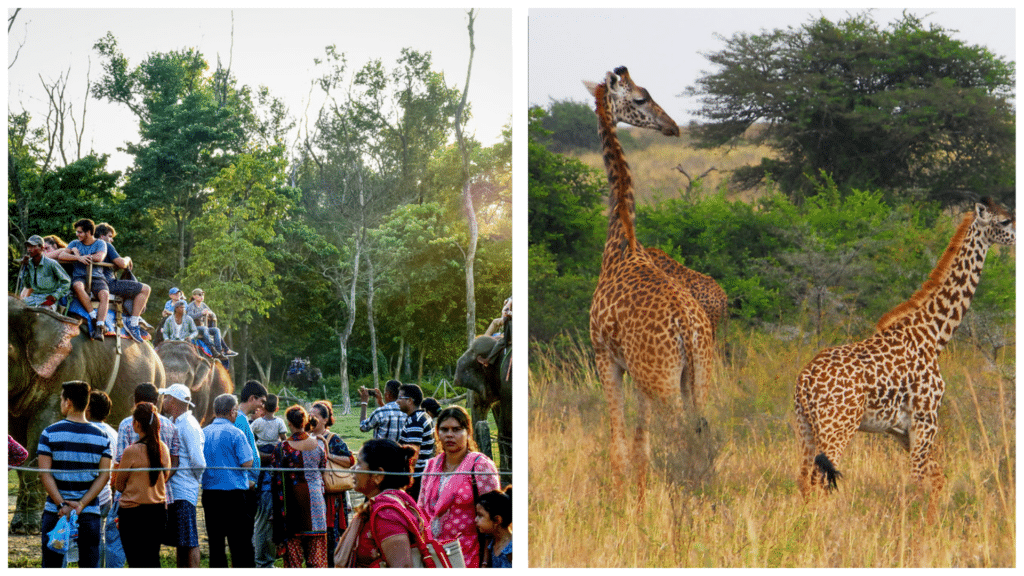Ethical wildlife tourism may be possible, but there are a few things that stand in our way. Keep reading to find out.

In recent years, sustainable travel has become a new topic of conversation, sparking a new way of travel for many tourists eager to see the world.
But while light has been shed on various aspects of the tourism industry, unveiling the harsh reality of animal abuse, environmental issues, and human rights abuse, more travellers are determined not to be mindful when planning trips.
In this article, we will focus on ethical wildlife tourism and explore whether it is possible or just a far-flung dream.
What is ethical wildlife tourism? – a brief overview

Before we get down to the nitty-gritty, let’s first establish the meaning behind ethical wildlife tourism. This term enables tourists to encounter wildlife worldwide — think sustainable African safaris or visiting an elephant orphanage in Thailand — which in turn does not negatively impact the animal’s welfare.
Believe it or not, there are many examples of unethical wildlife tourism, some of which you may have even taken part in without knowing, including visiting tiger temples, bathing elephants, or swimming with dolphins. The list goes on.
This dark side of tourism is sometimes hidden, allowing travellers, to believe they are not doing anything wrong. One example is bathing elephants, an activity that’s sold to tourists as ‘more ethical’ than riding an elephant.
While this is partly true, the sad fact is that these elephants still undergo the same training as those who give rides to tourists.
So, while it may look like elephants are living their best life in the water, and we are witnessing them in their natural habitat, the truth is that these animals are under strict human control, which is highly unethical.
Is ethical wildlife tourism possible? – wishful thinking or a real possibility

Wild animals are a valuable source of education for humans. Not only is ethical wildlife tourism possible, but it is also necessary for education and conservation to benefit community engagement and impact our personal growth.
The key to making this happen is to be 100% sure that companies have the animals’ best interests and welfare at heart, allowing us to continue to observe beautiful creatures across the globe without causing harm.
For this, it is important to show care, respect, and commitment to the places and animals we visit, and we must take responsibility for our actions by doing thorough research before taking part in an activity or experience involving animals.
Nearly every animal used in the tourism industry has its own story, whether captured at a young age, deprived of socialising in their natural environment, or their behaviours in the wild have changed because of human interaction.
Nevertheless, ethical wildlife tourism is what we strive for, enabling tourists to have zero impact on the wildlife they are witnessing, and many benefits come with this.
From much-needed conservation funding from tourists to boosting and empowering local communities, ethical wildlife tourism is the way forward.
What we can do – how to be a mindful tourist

It is one thing to demand that wildlife tourism companies change their ways, but it is another to refuse to stop participating in these activities ourselves.
As Mahatma Gandhi once said, “Whatever changes you would like to effect in your society have to begin with you.” It is our responsibility to evolve into mindful travellers.
By doing this, we do not encourage unethical companies to continue abusing animals but instead support ethical companies worldwide to bring about change. Remember, unethical wildlife tourism happens because tourists support it, so the change must begin with us.
By becoming conscientious travellers, we can ensure vital funds are going to the right places to maintain and increase the number of free-roaming animals. This not only protects animals against poachers but also raises awareness of local issues.
You might wonder how you can tell if something is ethical or unethical; as a rule of thumb, it is unethical if the activity harms the animal involved. Still, if the activity or attraction has no effect or a positive one, then it is ethical.
As the World Animal Protection states, “If you can ride, hug, or take a selfie with a wild animal, chances are the venue is cruel. Don’t go!” We know you may have added these to your travel bucket list of things to experience, but the right thing to do is research and research some more before committing to anything.
READ MORE: The 50 cutest cat names, ranked in order of cuteness

